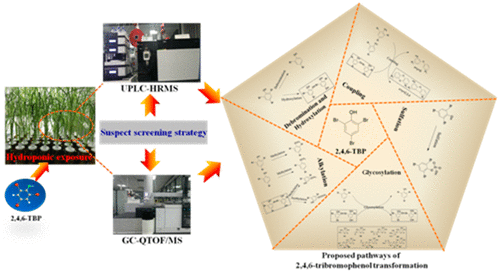当前位置:
X-MOL 学术
›
Environ. Sci. Technol.
›
论文详情
Our official English website, www.x-mol.net, welcomes your
feedback! (Note: you will need to create a separate account there.)
Multiple Metabolic Pathways of 2,4,6-Tribromophenol in Rice Plants.
Environmental Science & Technology ( IF 10.8 ) Pub Date : 2019-06-19 , DOI: 10.1021/acs.est.9b01514 Qing Zhang 1 , Yanwei Liu 1, 2 , Yongfeng Lin 1, 2 , Wenqian Kong 1, 2 , Xingchen Zhao 1 , Ting Ruan 1, 2 , Jiyan Liu 1, 2 , Jerald L Schnoor 3 , Guibin Jiang 1, 2
Environmental Science & Technology ( IF 10.8 ) Pub Date : 2019-06-19 , DOI: 10.1021/acs.est.9b01514 Qing Zhang 1 , Yanwei Liu 1, 2 , Yongfeng Lin 1, 2 , Wenqian Kong 1, 2 , Xingchen Zhao 1 , Ting Ruan 1, 2 , Jiyan Liu 1, 2 , Jerald L Schnoor 3 , Guibin Jiang 1, 2
Affiliation

|
Bromophenols occur naturally and are used globally as man-made additives in various industrial products. They are decomposition products of many emerging organic pollutants, such as tetrabromobisphenol A, polybrominated dibenzo- p-dioxin (PBDD), polybrominated diphenyl ethers (PBDE), and others. To characterize their biotransformation pathways, bromophenol congener 2,4,6-tribromophenol, being used most frequently in the synthesis of brominated flame retardants and having the greatest environmental abundance, was selected to hydroponically expose rice plants. After exposure for 5 days, 99.2% of 2,4,6-tribromophenol was metabolized by rice. Because of the lack of relative reference standards, an effective screening strategy was used to screen for potential metabolites that were further qualitatively identified by gas and liquid chromatography combined with high-resolution mass spectrometry. Forty transformation products were confirmed or tentatively identified at different confidence levels, including 9 phase I and 31 phase II metabolites. A large number of metabolites (39) were found in rice root, and 10 of them could be translocated and detected in rice stems or leaves. Many transformation pathways were proposed, including debromination, hydroxylation, methylation, coupling reactions, sulfation, and glycosylation. It was remarkable that a total of seven hydrophobic, persistent, and toxic OH-PBDEs and PBDD/Fs were found, indicating the biotic dimeric reactions of 2,4,6-tribromophenol that occurred in the rice plants. These results improve our understanding of the transformation and environmental fates of bromophenols, and they indicate new potential sources for OH-PBDEs and PBDD/Fs in the environment, especially in food chains.
中文翻译:

水稻植物中2,4,6-三溴酚的多种代谢途径。
溴酚是天然存在的,并且在全球范围内广泛用作各种工业产品中的人造添加剂。它们是许多新兴有机污染物的分解产物,例如四溴双酚A,多溴二苯并二恶英(PBDD),多溴二苯醚(PBDE)等。为了表征其生物转化途径,选择溴化苯酚同源物2,4,6-三溴苯酚(最常用于溴化阻燃剂的合成并具有最大的环境丰度),以水培方式暴露水稻植株。暴露5天后,大米代谢了99.2%的2,4,6-三溴苯酚。由于缺乏相对的参考标准,一种有效的筛选策略用于筛选潜在的代谢产物,这些产物通过气相色谱和液相色谱结合高分辨率质谱进一步定性鉴定。在不同的置信度水平上已确认或初步确定了40种转化产物,包括9种I期和31种II期代谢物。在稻根中发现了大量的代谢物(39种),其中有10种可以在稻茎或叶中转移和检出。提出了许多转化途径,包括脱溴,羟基化,甲基化,偶联反应,硫酸化和糖基化。值得注意的是,总共发现了七个疏水,持久和有毒的OH-PBDEs和PBDD / Fs,表明水稻植物中发生了2,4,6-三溴苯酚的生物二聚反应。
更新日期:2019-06-20
中文翻译:

水稻植物中2,4,6-三溴酚的多种代谢途径。
溴酚是天然存在的,并且在全球范围内广泛用作各种工业产品中的人造添加剂。它们是许多新兴有机污染物的分解产物,例如四溴双酚A,多溴二苯并二恶英(PBDD),多溴二苯醚(PBDE)等。为了表征其生物转化途径,选择溴化苯酚同源物2,4,6-三溴苯酚(最常用于溴化阻燃剂的合成并具有最大的环境丰度),以水培方式暴露水稻植株。暴露5天后,大米代谢了99.2%的2,4,6-三溴苯酚。由于缺乏相对的参考标准,一种有效的筛选策略用于筛选潜在的代谢产物,这些产物通过气相色谱和液相色谱结合高分辨率质谱进一步定性鉴定。在不同的置信度水平上已确认或初步确定了40种转化产物,包括9种I期和31种II期代谢物。在稻根中发现了大量的代谢物(39种),其中有10种可以在稻茎或叶中转移和检出。提出了许多转化途径,包括脱溴,羟基化,甲基化,偶联反应,硫酸化和糖基化。值得注意的是,总共发现了七个疏水,持久和有毒的OH-PBDEs和PBDD / Fs,表明水稻植物中发生了2,4,6-三溴苯酚的生物二聚反应。


















































 京公网安备 11010802027423号
京公网安备 11010802027423号